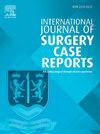Superior mesenteric artery syndrome: A rare cause of proximal bowel obstruction— Case report and literature review
IF 0.6
Q4 SURGERY
引用次数: 0
Abstract
Introduction and importance
Superior mesenteric artery syndrome, or mesenteric root syndrome, is a rare cause of small bowel obstruction. Delay in diagnosis may lead to significant morbidity and mortality in pediatric patients across several age groups.
Case presentation
We present a 10-year-old female child who has experienced numerous acute abdominal episodes since she was six years old. Before it was determined that the patient had superior mesenteric artery syndrome, she had a number of medical treatments, including an anti-Helicobacter pylori regimen, antibiotic medications, and anemia treatment. The patient received dietary support and medical counsel, and she is currently receiving follow-up care.
Clinical discussion
In some cases, the disease may exhibit a subclinical course, and most patients will not receive appropriate treatment but rather be treated symptomatically. In cases where the condition course is severe, nutritional buildup of the patient for gaining weight and sometimes surgical intervention will suffice for definite treatment.
Conclusion
Superior mesenteric artery syndrome is a clinical entity causing acute abdominal pain and requiring prompt attention. The differential diagnosis of abdominal pain is crucial for the diagnosis of superior mesenteric artery syndrome, particularly in children who have experienced weight loss in the past.
求助全文
约1分钟内获得全文
求助全文
来源期刊
CiteScore
1.10
自引率
0.00%
发文量
1116
审稿时长
46 days

 求助内容:
求助内容: 应助结果提醒方式:
应助结果提醒方式:


